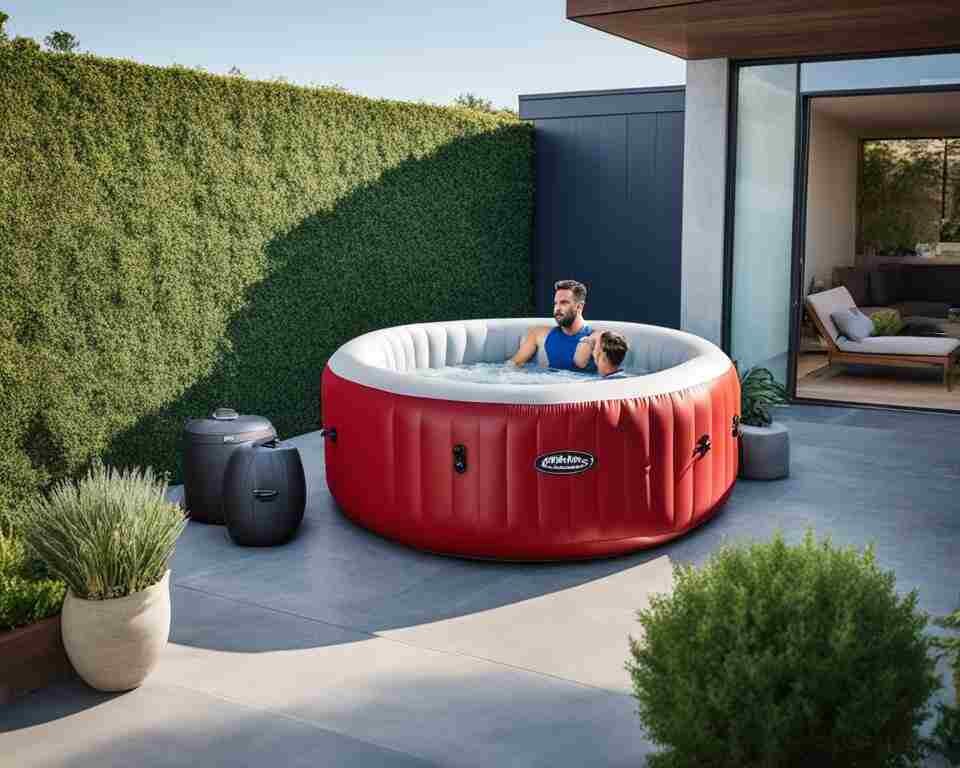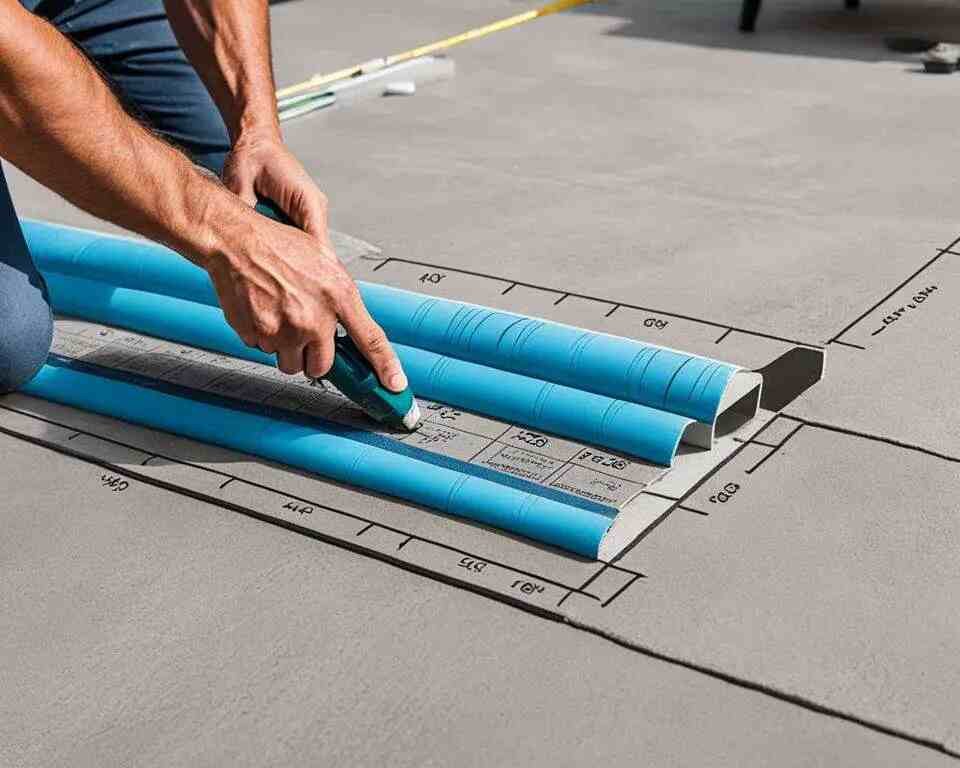Are you thinking about setting up an inflatable hot tub in your backyard? If you have a concrete surface, you may be wondering if it’s safe to place your hot tub on it. In this guide, I will provide you with all the information you need to know about putting an inflatable hot tub on concrete and ensure a secure setup.
A standard five-seater hot tub weighs around 2,000kg when it’s full of water and people, so it’s crucial to create a flat and solid foundation on concrete for stability and safety. To install an inflatable hot tub on concrete, you need to consider factors such as the thickness of the concrete slab, slope for proper drainage, and compatibility with electrical installations.
Key Takeaways:
- Placing an inflatable hot tub on concrete is safe and secure if certain factors are considered.
- Ensure the concrete slab is thick enough, at least four inches, to support the weight of the hot tub.
- Proper slope and drainage of the concrete surface are essential to prevent water pooling under the hot tub.
- Compatibility with electrical installations should be ensured, following safety guidelines and using appropriate materials.
- Regular inspections and maintenance of the concrete base are necessary to identify any potential cracks or damage.

The Basics of Installing a Hot Tub Base
Before installing a hot tub base, I always recommend conducting a site survey to determine the most suitable location and type of hot tub foundation. A sturdy spa foundation is crucial to support the weight of the hot tub and ensure its stability and safety. There are different types of bases to choose from, each with its own advantages and considerations. These include:
- Concrete slabs
- Decking
- Gravel
- Paving stones
Each type of hot tub base offers unique benefits. Concrete slabs provide a strong and durable foundation, while decking can enhance the visual appeal of your outdoor space. Gravel is an affordable and easy-to-install option, and paving stones offer an attractive and sturdy base for your hot tub. It’s important to carefully consider the pros and cons of each type, taking into account factors such as budget, maintenance requirements, and the overall aesthetic you desire for your hot tub area.
Regardless of the type of base you choose, it’s essential to ensure that the hot tub base is level. A level base is crucial for proper water distribution within the hot tub, preventing any potential damage. Uneven surfaces can place stress on the hot tub and lead to water pooling or leakage, ultimately affecting the lifespan and performance of the hot tub. Therefore, investing the time and effort to level the base properly is well worth it in the long run.
| Type of Hot Tub Base | Advantages | Considerations |
|---|---|---|
| Concrete Slabs | Strong and durable foundation | Higher cost and more complex installation |
| Decking | Visually appealing | Requires regular maintenance and may have weight restrictions |
| Gravel | Affordable and easy to install | May shift over time and require occasional replenishment |
| Paving Stones | Attractive and sturdy base | Higher cost and labor-intensive installation |
Types of Hot Tub Bases
When it comes to choosing the right base for your hot tub, there are several options available. Each type of base offers its own unique benefits and considerations. Let’s take a closer look at the different types of hot tub bases:
1. Concrete Slabs
A concrete slab is a popular choice for hot tub bases due to its strength and durability. It provides a stable foundation for your hot tub and can easily support its weight. Concrete slabs are long-lasting and require minimal maintenance.
2. Decking
Decking offers a visually appealing option for hot tub bases. It creates a seamless transition between your hot tub and the surrounding outdoor space. Decking materials such as wood or composite can add an aesthetic touch to your hot tub area.
3. Gravel
Gravel is a cost-effective and easy-to-install base option for hot tubs. It provides good drainage and helps to prevent water from pooling around the hot tub. However, it may require occasional leveling and maintenance.
4. Paving Stones
Paving stones offer an attractive and sturdy base for hot tubs. They come in various shapes, sizes, and patterns, allowing you to customize the look of your hot tub area. Paving stones provide stability and can withstand heavy loads.
5. Foam Hot Tub Pads
Foam hot tub pads are designed to provide protection and insulation for your hot tub. They are made from durable foam materials that help to distribute the weight evenly and create a solid foundation. Foam pads also offer insulation benefits, helping to retain heat.
6. Prefabricated Plastic Hot Tub Tiles
Prefabricated plastic hot tub tiles are a versatile and easy-to-install base option. These interlocking tiles allow for customization, as you can create different patterns and designs. They provide a stable surface and can be easily removed or replaced if needed.
Each type of hot tub base has its own considerations and benefits. Consider factors such as durability, aesthetics, ease of installation, and maintenance requirements when choosing the right base for your hot tub. It’s important to select a base that not only supports the weight of your hot tub but also complements the overall design of your outdoor space.

Leveling the Hot Tub Base
Having a level hot tub base is essential for proper water distribution and to prevent any potential damage to your hot tub. Even a slight tilt in the base can disrupt the flow of water inside the tub, resulting in an uneven and less enjoyable experience. To ensure a level base, there are two common methods that you can employ: using shims or utilizing a spa leveller.
Shims:
Shims are small, wedge-shaped pieces that can be placed under the low end of the hot tub base to create a level surface. By strategically positioning shims, you can adjust the height of the base in specific areas, compensating for any irregularities or slopes in the ground. It is recommended to use shims made of durable and weather-resistant materials, such as plastic or composite, as they will withstand the weight of the hot tub and provide long-lasting stability.
Spa Leveller:
A spa leveller is a platform equipped with adjustable feet that allows you to easily level your hot tub base. This option is particularly convenient if you have a larger hot tub or prefer a more precise and effortless leveling process. With the adjustable feet, you can fine-tune the height of each corner of the base, ensuring a perfectly level surface. Spa levellers are designed to withstand the weight of the hot tub and provide a sturdy foundation.
Regardless of the method you choose, it is important to strive for a near-perfect level base. This minimizes the risk of the hot tub rocking or becoming unstable, which could lead to potential damage to the tub and compromise your overall hot tub experience.
| Method | Description |
|---|---|
| Shims | Small wedge-shaped pieces placed under the low end of the base to create a level surface. |
| Spa Leveller | Platform with adjustable feet that allows for precise leveling of the hot tub base. |
Note: Use the method that best suits your needs and preferences. Both shims and spa levelers are effective in achieving a level hot tub base.
Placing an Inflatable Hot Tub on Concrete
When it comes to setting up your inflatable hot tub, placing it on a concrete surface can provide a safe and secure foundation. Concrete slabs offer stability, durability, and ease of installation, making them an ideal choice for supporting your hot tub.
Before placing your inflatable hot tub on concrete, there are a few important considerations to keep in mind. First and foremost, ensure that the concrete slab is thick enough, with a minimum thickness of four inches. This will ensure that the slab can adequately support the weight of the hot tub, even when it’s filled with water and people.
Additionally, it’s essential that the concrete surface is slightly sloped to allow for proper drainage. This will prevent water from pooling around the hot tub and potentially causing damage.
To ensure the safety of your electrical installations, it’s recommended to use steel-wired armoured (SWA) cable or PVC piping for outdoor cabling. This will protect the wiring from environmental factors and provide a reliable and secure connection.
By placing your inflatable hot tub on a concrete surface, you’ll benefit from the stability and durability that concrete provides. It offers a solid foundation that can withstand the weight of the hot tub and ensure its longevity. Additionally, the ease of installation on a concrete surface simplifies the setup process, allowing you to enjoy your hot tub sooner.

Pros and Cons of Placing an Inflatable Hot Tub on Concrete
| Pros | Cons |
|---|---|
| Stability and durability | Requires a level and properly sloped surface |
| Easy installation | May require professional assistance for electrical connections |
| Longevity | Concrete surface may require occasional maintenance and repairs |
| Compatible with electrical installations | Concrete surface can be cold, requiring additional insulation |
By considering these factors and weighing the pros and cons, you can make an informed decision about placing your inflatable hot tub on concrete. Whether you choose a concrete foundation or another type of base, it’s crucial to ensure stability, durability, and compatibility with your specific hot tub model and needs.
Considerations for Placing an Inflatable Hot Tub on Concrete
The first consideration is the levelness of the concrete slab. A level base is essential to prevent any uneven weight distribution and potential damage to the hot tub. Ensure that the concrete slab is level by using a spirit level or consulting a professional if needed.
Another consideration is proper drainage. The concrete slab should have adequate slope to allow water to flow away from the hot tub. This prevents water from pooling underneath and causing potential damage. If the slope of the concrete slab is insufficient, consider installing a drain or creating a slope using leveling materials.
Compatibility with electrical installations is also crucial. When placing the hot tub on concrete, ensure that the electrical wiring and connections are safely integrated. Follow safety guidelines and use appropriate materials such as steel-wired armoured (SWA) cable or PVC piping for outdoor cabling.
Lastly, it’s important to ensure that the concrete slab can support the weight of the hot tub when it is filled with water and people. Contact the hot tub manufacturer or consult with a structural engineer to determine the load-bearing capacity of the concrete slab. This will help prevent any structural issues or safety concerns.
By considering these factors, you can create a secure and stable setup for your inflatable hot tub on concrete, ensuring a safe and enjoyable experience.
Benefits of Placing an Inflatable Hot Tub on Concrete
When it comes to creating a stable and secure setup for your inflatable hot tub, placing it on a concrete foundation offers numerous benefits. Concrete provides a strong and durable base that can easily support the weight of the hot tub without any shifting or settling over time. This ensures a reliable and long-lasting installation that you can enjoy for years to come.
In addition to its stability, concrete also offers excellent insulation and heat retention properties. The thickness of the concrete slab helps trap and maintain the heat inside the hot tub, allowing you to indulge in a relaxing soak even during cooler evenings. This enhanced insulation not only contributes to a more enjoyable hot tub experience but also helps in conserving energy and reducing heating costs.
Furthermore, concrete is a low-maintenance option for your hot tub base. It is resistant to weather elements, such as rain, snow, and UV rays, making it suitable for both indoor and outdoor installations. Unlike other materials that may require frequent upkeep, concrete requires minimal maintenance, providing you with more time to focus on relaxation and enjoyment.
Another advantage of placing your inflatable hot tub on concrete is its ability to seamlessly blend with the surrounding outdoor space. Concrete can be customized with various finishes, such as staining or stamping, to create a cohesive and aesthetically pleasing look. Whether you have a modern, rustic, or traditional outdoor setting, concrete can complement any design style, adding value and visual appeal to your overall hot tub setup.
To summarize, here are the key benefits of placing an inflatable hot tub on concrete:
- Stability and durability
- Excellent insulation and heat retention
- Low maintenance
- Compatibility with various outdoor designs
By choosing a concrete foundation for your inflatable hot tub, you can enjoy the advantages of a stable and long-lasting setup that enhances your hot tub experience. Let your worries melt away as you relax in the comfort and luxury of your hot tub, placed securely on a concrete base.
| Benefits of Placing an Inflatable Hot Tub on Concrete |
|---|
| Stability and durability |
| Excellent insulation and heat retention |
| Low maintenance |
| Compatibility with various outdoor designs |
Precautions for Placing an Inflatable Hot Tub on Concrete
While placing an inflatable hot tub on concrete is generally safe, it’s important to take some precautions to ensure a secure and long-lasting installation. Here are some essential considerations:
- Slope for proper drainage: The concrete slab should be properly sloped to prevent water pooling under the hot tub. This is crucial to avoid potential damage and maintain a safe environment.
- Compatibility with electrical installations: Ensure that the electrical installations on the concrete flooring are in accordance with safety guidelines. Use appropriate materials, such as steel-wired armoured (SWA) cable or PVC piping, to protect the electrical connections from external elements.
- Regular inspections and maintenance: Conduct regular inspections of the concrete base to identify any signs of cracks or damage. Promptly address any issues to maintain the structural integrity of the foundation and prevent further problems down the line.
By adhering to these precautions for placing an inflatable hot tub on concrete, you can enjoy a secure and worry-free experience, maximizing the longevity and performance of your hot tub.

Tips for Placing an Inflatable Hot Tub on Concrete
When placing an inflatable hot tub on concrete, there are some important tips to keep in mind to ensure a successful installation.
- Ensure the concrete slab is thick enough: The concrete slab should be at least four inches thick to provide a strong and stable foundation for the hot tub. This thickness will help distribute the weight of the hot tub and prevent any potential cracks or damage.
- Properly slope the concrete for drainage: It’s essential to slope the concrete slab slightly to allow for proper drainage. This slope will prevent any water from pooling beneath the hot tub, avoiding any potential damage or water-related issues.
- Use appropriate materials for electrical installations: When installing electrical connections for your hot tub, it’s crucial to use appropriate materials and follow safety guidelines. Consider using steel-wired armoured (SWA) cable or PVC piping for outdoor cabling, ensuring a secure and safe electrical setup.
- Add a foam hot tub pad for protection and insulation: Consider adding a foam hot tub pad underneath the hot tub for added protection and insulation. This pad will protect the hot tub from any rough surfaces and provide additional insulation, helping to maintain water temperature and energy efficiency.
- Regularly inspect the concrete slab: It’s important to regularly inspect the concrete slab for any signs of cracks or damage. By identifying and addressing any issues early on, you can prevent any potential problems from escalating and ensure the longevity of your hot tub installation.
By following these tips, you can confidently place your inflatable hot tub on a concrete foundation, ensuring a secure and enjoyable experience.
| Tip | Description |
|---|---|
| Ensure the concrete slab is thick enough | The concrete slab should be at least four inches thick to provide a strong and stable foundation for the hot tub. |
| Properly slope the concrete for drainage | Ensure the concrete slab is sloped slightly to allow for proper drainage. |
| Use appropriate materials for electrical installations | Choose suitable materials and follow safety guidelines for the electrical connections of the hot tub. |
| Add a foam hot tub pad for protection and insulation | Consider using a foam pad underneath the hot tub for added protection and insulation. |
| Regularly inspect the concrete slab | Regularly inspect the concrete slab for any signs of cracks or damage to ensure the longevity of the installation. |
Conclusion
After careful consideration, it is clear that placing an inflatable hot tub on a concrete foundation is the ideal choice for a safe and secure setup. Concrete provides a strong and durable base that offers stability and support for the hot tub. By ensuring proper slope and drainage, you can prevent any water pooling under the hot tub, ensuring a clean and hygienic environment.
Compatibility with electrical installations is crucial to guarantee both safety and functionality. Following the necessary precautions and using appropriate materials for outdoor cabling, such as steel-wired armoured (SWA) cable or PVC piping, will ensure a reliable and worry-free experience.
By carefully planning the installation process and considering all the factors mentioned, you can create a secure and stable setup for your inflatable hot tub on concrete. Enjoy the benefits of durability, ease of installation, and compatibility with outdoor spaces by placing your hot tub on concrete. It’s time to sit back, relax, and indulge in the ultimate hot tub experience.

